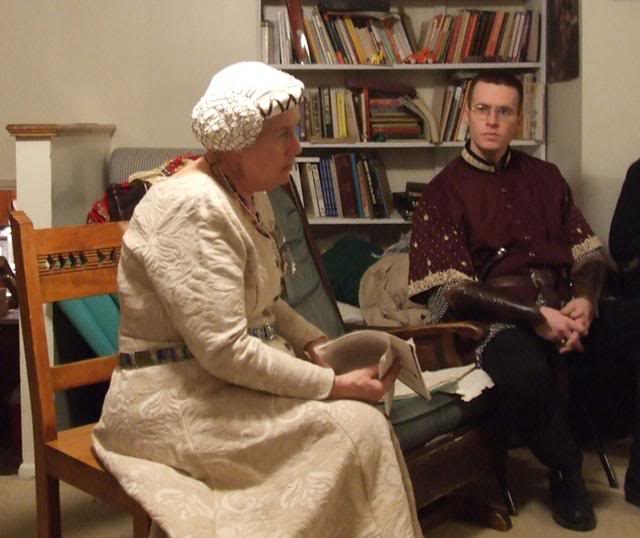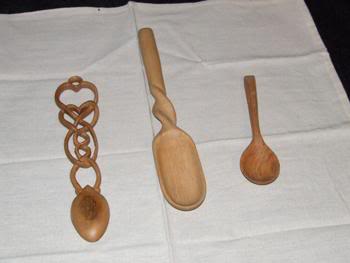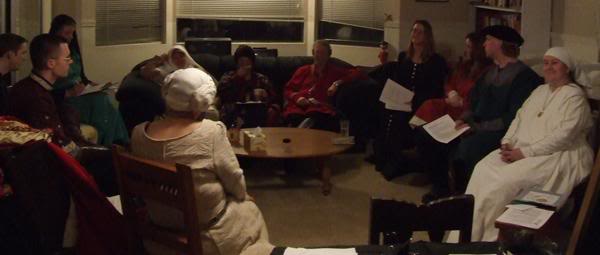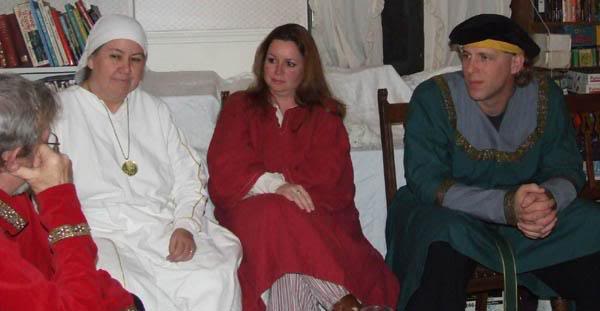 Preparing for Kingdom A&S Competitions
Preparing for Kingdom A&S Competitions(as an entrant and an attendee)
Mistress Monika von Zell, Mistress of the Pelican and of the Laurel
March 1, 2006
 Preparing for Kingdom A&S Competitions
Preparing for Kingdom A&S CompetitionsMistress Monika von Zell, Mistress of the Pelican and of the Laurel
She also brought many beautiful objects to show us: Wooden spoons by Master Jochen; a scroll by Baroness Sarah de Montgomery; and a beautiful red dress and matching cap by _______ .
Kingdom A&S is one type of competition, and the most intense in-kingdom. Inter-Kingdom competitions (such as the one at Estrella) can be even more competitive. In order to be Kingdom A&S Champion, you have to enter at least three items in at least 2 categories. The current Kingdom A&S Champ is Lady Jorunn nic Lochlainn. There are other types of competition, such as Queen’s Prize, which is much more of an exhibition, where everyone usually gets a prize.
Handout: Kingdom A&S Rules and Judging sheets.
Mistress Monika drew our attention to the importance of documentation, which is a huge part of the educational aspect of the society; she observed that when we do documentation, the primary person we are educating is ourselves! She also pointed out that most of us have already done documentation, whether for our name or device or persona or even that piece of garb. What’s required for a competition is just writing it up.
Handouts: One Page Documentation, Step by Step Documentation, Interacting with History, Useful Internet Documentation (for cookery)
A note on “primary” sources: “Primary” is the object (bowl, dress, helmet) itself, but that’s tricky because so many objects are lost, disintegrated, or else firmly contained in museums. Therefore, for SCA purposes, a picture in a museum or a clear reference in a medieval manuscript can serve as primary documentation. Even if you saw the picture or read the text in a book or on the web, BE SURE to tell the judges the name of the museum or the name of the manuscript itself.
Another nice thing to do in your documentation is color copies, if you can afford them.
Mistress Monika showed us a number of examples of good & bad documentation. She also talked a little bit about what NOT to do—the most notable examples were cases where someone had photocopied a page out of a book and circled one of the pictures or highlighted a line of text. This has at least three problems:
Handout: Ten Simple Things You Can Do To Impress the Judges
 Mistress Monika observed that presentation and display also count.
Mistress Monika observed that presentation and display also count.
Mistress Monika emphasized several times that SCA A&S competitions are sort of like the Science Fair. Your documentation should answer the same sorts of questions: who what when where why. She also noted that the “science-fair trifold” method of presentation is a good method and is becoming more popular in SCA A&S competitions.
She emphasized that substitutions may be necessary, but be sure to note and explain them! Don’t try to pretend that your rayon blend fabric is linen, because the judges will catch on. But if you explain that the garment would have been made with linen, and how and why you substituted rayon, it will go much better for you.
On the judging sheet, complexity is a factor. Mistress Monika explained this in terms of the “sheep to shawl” kind of demonstration, where carding, spinning, and dyeing are demonstrated in addition to knitting. All else equal, more complex = more points. For a cooking competition, one might make the cheese used in a cheesecake. For an item such as a wooden spoon, one might make some of the tools used to make the spoon.
 Mistress Richenza reminded us that it’s worthwhile to do your research BEFORE you start the project, since it’s heartbreaking to spend a long time on a work of art and then discover that you can’t document it.
Mistress Richenza reminded us that it’s worthwhile to do your research BEFORE you start the project, since it’s heartbreaking to spend a long time on a work of art and then discover that you can’t document it.
There was a brief discussion of the rules about re-entering items; generally you shouldn’t re-enter an item that has won a higher level of competition (if it won at Estrella, don’t enter it in the Baronial competition!), nor should you re-enter the same item again next year. There’s probably an exception if last year’s entire item is a small part of this year’s new entry; e.g. if you entered a hat last year and enter the entire outfit this year.
Mistress Monika concluded by encouraging us again to visit Kingdom A&S, ask questions (but not interrupt the judges!) and support the artists and the Arts & Sciences.
Those present in addition to Countess Monika von Zell: Lady Ia, Lady Jane, Mistress Richenza, Lady Viviana, Sir Jochen, Lady Kymma, Karl, Asta, AElflaed, William, Kendrick, Bardolf


